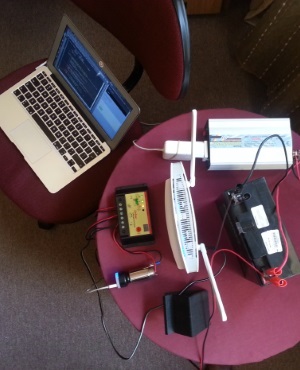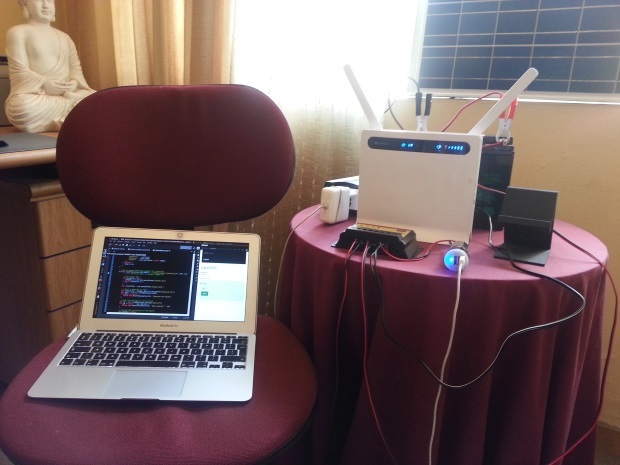Beat load-shedding with solar tech

UPDATE: We built an app at IBM Research that allows you to design your own solar power system: https://empowersolar.mybluemix.net
For several years I've been using a simple solar setup at home to keep my laptop and internet router(s) running during thunderstorms and power outages. I meant to blog about the setup, but since loadshedding has become frequent (and a hot topic), I was featured in Fin24 and HTXT recently.
The HTXT article goes into more detail than the "dumbed-down" Fin24 article. There is still a lot of confusion, as can be seen from the comments posted, so I thought I'd clarify a few things.
Lightning storms
My main goal was to be able to continue working during lightning storms. I also wanted to be able to leave my equipment connected during lightning storms, without fear of lightning damage (as has happened to me previously). This means that in the middle of the night, I shouldn't have to wake up and start unplugging things when I hear thunder.
To enable this, I ensured that my router could run continuously off a battery that was not being charged from the power line (as this would expose it to lightning risk). In addition, I often leave downloads to run overnight (since I have separate night-time bandwidth), so I connected and set up a Raspberry Pi to run the downloads. This is far more battery-efficient that using a laptop to run downloads.
Load-shedding
During load-shedding, I wanted to be able to continue working. I typically work during the day, which means that there is typically sunlight outside. This allows me to take a short-cut: run my laptop off the solar panel while there is sunlight outside. Since I was unable to get a cigarette socket laptop charger for my MacBook, I resorted to using an inverter.
How long can this system run for?
In order to figure out how big the solar panel needs to be, how much capacity the battery needs, how many things you can connect to the setup, and how long it will run for, you need to use the following equation:
Power = Volts * Amps
So, a typical alarm battery, rated at 12V and 7 amp-hours (meaning you can draw 7 amps for 1 hour) should be able to supply: 12V*7Ah = 84 watt-hours (i.e. 84 watts for 1 hour). However, since you can only drain a lead-acid battery to 50% before doing damage, you'd halve to get at 42 watt-hours.
Great, now we know how much energy the battery can supply, let's figure out how long things can run for. I connected up my router and measured the current flowing through it. It draws 0.2 amps (on average). That means it uses about 2.4 watt-hours. Connecting that to a fully-charged 7Ah battery then gives us a run-time of about 42Wh / 2.4Wh = 17.5 hours. That's pretty good, because within 17.5 hours, the sun should be back up and charging up the battery again! I used a larger 18Ah battery, so I could even connect up a Raspberry Pi, which I measured at using an average of 1Wh.
Great! So how big a solar panel do I need? If we assume that the battery is drained before charging begins, and that we can get 4 hours of direct sunlight to the panel (no shadows!), then to charge up the 42 watt-hours we used up, we need: 42Wh / 4 hours = 10.5 watt panel. Note: if there is a shadow even across a corner of the solar panel, it's entire output will be reduced drastically.
One more thing though: what if the power went out, and I want to use my laptop off the battery? I measured my laptop (MacBook Air with Core i5 processor) energy usage via an inverter connected to the battery: it varies between 10 watts and 30 watts depending on what I'm doing (and screen brightness!), and averages around 20 watts. This means that if I use a 30 watt panel, I should be able to run the laptop and still be able to charge up the battery, while the sun is shining on the panel. I found that, yes indeed, in practise, this setup does work and is fairly portable and cheap!
In the articles, I've suggested a 50 watt panel and an 18 amp-hour battery, to be safe. This also means that you should be able to use a beefier laptop. Remember though, that as soon as the panel no longer receives sunlight, you will start draining the battery. Since an 18Ah battery can supply 108Wh of energy, I could run the laptop + router + Raspberry Pi off the battery for: 108Wh / (20W + 2.4W + 1W) = 4.6 hours. This is without using any of the charge in the laptop's own battery. In practise though, I disconnect the laptop from the battery as soon as the panel stops charging the battery, so that the router can continue to run overnight.

For more information, do check out the Fin24 and HTXT articles.
